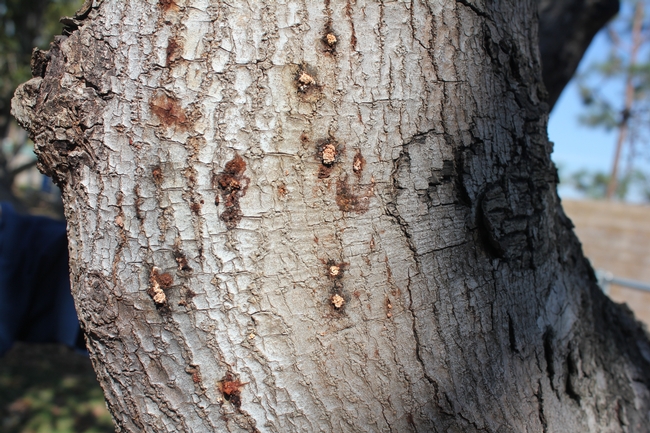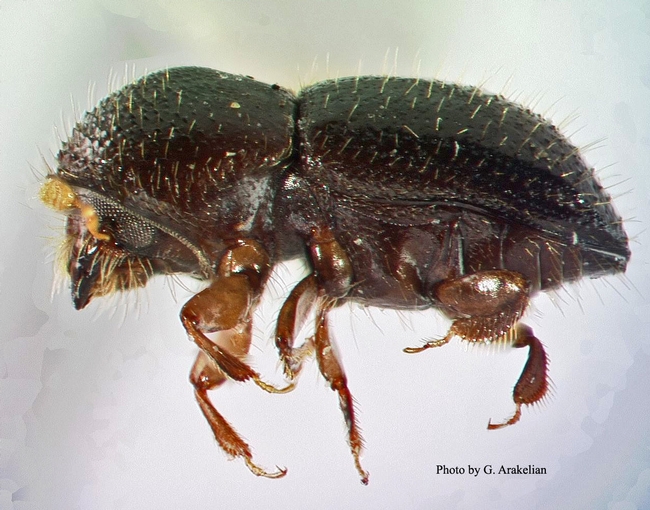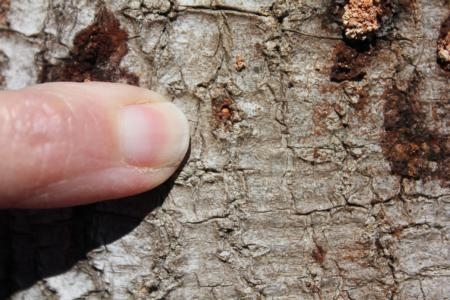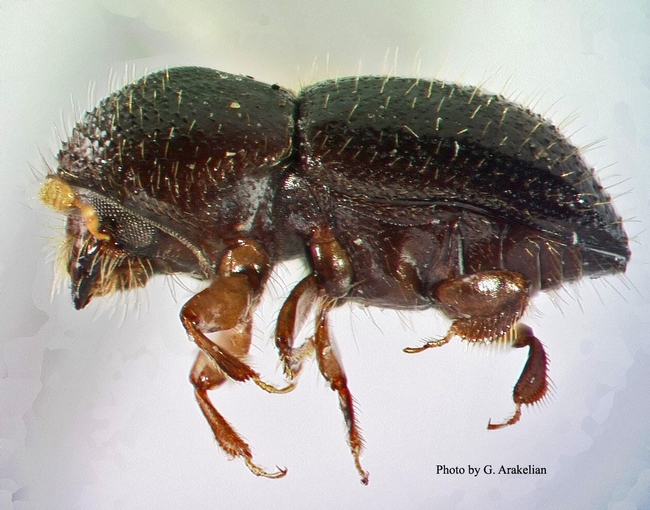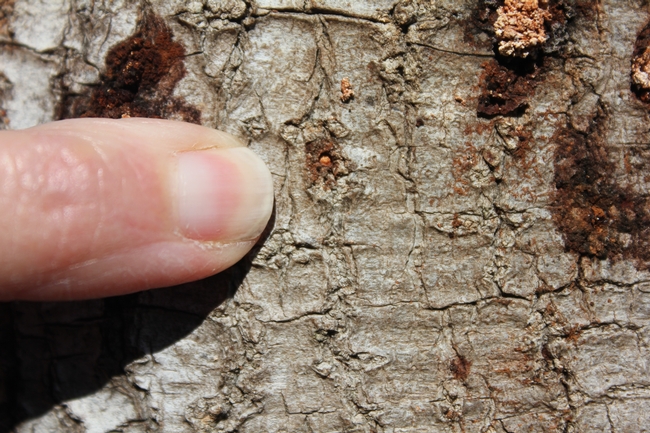Posts Tagged: polyphagous shot hole borer
UC Cooperative Extension uses UC Irvine campus as a living lab
"The beauty of UCI is that it's a university, and they're used to researchers," said John Kabashima, an environmental horticulture advisor and entomologist with the UC Cooperative Extension in Orange County.
Another scientist on the project is Akif Eskalen, UC Cooperative Extension plant pathology specialist based at UC Riverside. Eskalen first identified the sesame seed-sized beetle in a South Gate avocado tree in 2012.
Eskalen selected 130 sycamores at UCI for his experiment and divided them into 13 groups of 10. Four of the groups were treated with different insecticides; three were treated with different fungicides; and four others got one of each. Another group was given a beneficial bacteria found in some California trees that's thought to kill the fungus. A final group is serving as a control and received no treatment at all.
The scientists are allowed to cut down and section the trees, sample them, and even leave some infested trees alone. Having this flexibility is essential to understanding the success — or failure — of a given pesticide, Kabashima said: "That's why we're learning so much here at UCI."
UC Irvine gets landscape tree help from UC ANR
Hundreds of landscape trees on the UC Irvine campus have been infested with polyphagous shot hole borer, a pest introduced into California from Asia. UCI has assembled a team that includes UC Agriculture and Natural Resources experts to develop a management plan for identifying, removing, treating and replacing the ravaged trees, according to a UCI press release.
Polyphagous shot hole borer has been present on the campus for two to three years. The extent of the infestation became apparent in the last few months when a significant number of trees began showing severe symptoms. UCI groundskeepers began to more closely examine a number of trees that appeared to be particularly distressed and worked with UC ANR staff to identify PSHB in early 2015.
A team of UCI staff qualified in tree management is receiving training from UC ANR (UC Riverside and UCCE) to properly identify and assess PSHB infestation. The team will monitor all trees on the UCI campus and, with input from faculty and students from UCI's Center for Environmental Biology, make the determination about which infected trees will be removed.
The news release suggests area property owners who suspect their own trees are infested with PSHB contact John Kabashima, UC ANR environmental horticulture advisor at the UC South Coast Research and Extension Center, 7601 Irvine Blvd., Irvine, CA 92618, pshb.ucce.oc@gmail.com.
Sesame seed-size insect is victimizing trees in Southern California
The polyphagous shot hole borer is taking up residence in California trees from San Diego to Santa Monica and as far east as Riverside County, drilling circular tunnels and spreading fungal spores that kill trees from the inside out, reported Amina Kahn in the Los Angeles Times Science Blog.
Akif Eskalen, UC Cooperative Extension plant pathology specialist at UC Riverside, wants to contain this invasive bug before it spreads throughout Southern California.
"If we can't control them," Eskalen said, "they are going to wipe out all our trees."
Box elders, sycamores, American sweetgum, maple and coast live oaks are susceptible to polyphagous shot hole borer attack. In urban and suburban areas, the dead and dying trees can pose fire and limb falling dangers. In the agricultural sector, avocado trees could face huge financial losses. In the fight against the pest, the California Avocado Commission has provided Eskalen $800,000 to broaden his investigation into this mysterious species of ambrosia beetle.
In March, Eskalen and his colleagues - UC Riverside entomologist Richard Stouthamer and Huntington Library curator of woody collections Tim Thibault - spent two weeks in Vietnam, where PSHB originates, searching forests and fields for natural enemies of the fungus spread by the pest. They collected a host of possible allies, whose DNA is now being analyzed in the lab.
"I am very hopeful that we are going to find some solutions to control this fungus," Eskalen said. "We have to."
Have you seen a Polyphagous shot hole borer lately?
The “Invasive Ambrosia Beetle Public Meeting” that took place on Aug. 14 in Riverside, Calif., turned the spotlight on a beetle named “Polyphagous shot hole borer.” The PSHB has spread in Los Angeles and Orange counties. Both the beetle and a fungus it spreads were found on several backyard avocado trees in residential neighborhoods in these counties earlier this year. The beetle is responsible for the death of box elder trees in Long Beach in 2010. The box elder is one of the best hosts for the PSHB.
The beetle is very small and hard to see. Females are black in color and 0.07-0.1 inch long. The beetle burrows into the wood, leaving a hole (there are often many entry holes on an infested tree). The beetle then infects the host plant with a new Fusarium fungus, which it carries in its mandibles, a result of a symbiotic relationship between the beetle and fungus.
The fungus, in turn, attacks the vascular tissue of the tree, disrupting water and nutrient flow within the tree and eventually causing branch dieback. Fusarium dieback symptoms on avocado include a white powdery exudate — either dry or surrounded by wet discoloration of the outer bark — around a beetle entry hole.
The panelists at the public meeting were UC Riverside's Mary Lu Arpaia, UC Cooperative Extension specialist in the Department of Botany and Plant Sciences at UC Riverside, subtropical horticulture; Akif Eskalen, UCCE specialist in the Department of Plant Pathology; Mark Hoddle, UCCE specialist in the Department of Entomology and the director of the Center for Invasive Species Research; Timothy Paine, professor in the Department of Entomology; and Richard Stouthamer, professor in the Department of Entomology. They were joined by Zvi Mendel of the Agricultural Research Organization, Israel; Donald Hodel, UCCE advisor in Los Angeles County; Tom Roberts of the pest management industry; and Tom Coleman of the U.S. Department of Agriculture Forest Service.
The panelists explained that the beetle may have come from Southeast Asia or possibly Africa. There is no good solution for dealing with the beetle and the fungus. Preventive management, including sanitation, is the best option.
Several speakers advised not to move infested wood away from an infected zone and not to accept mulch from infected areas. Growers were advised to monitor the nutritional status of their trees, chip infested branches within the infested area and sterilize tools between cuts. Proper irrigation of trees was also recommended because over-watered and under-watered trees attract this beetle.
The PSHB appears to be “tasting” different trees in search for a good host. Neither the adults nor the larvae eat the plants and wood; they live in “galleries” within the tree and feed on the fungus.
Much about the PSHB remains unknown. What is known is that the beetle population can expand its range by about 12 miles a year. The beetle flies from tree to tree, and up and down a tree as well. Facilitated movement — packing wood, firewood — helps transport the beetle to far off places.
Chemical control has, so far, not been effective on the PSHB. Tarping or enclosing infested material is one of the solutions being considered. Heat treatment, fumigation and burning are other options on the table. Chipping and grinding are the best options at the moment.
The beetle is able to reproduce in only a small number of tree species. Known suitable hosts of the both PSHB and fungus are box elder, avocado, castor bean, English oak, coast live oak, silk tree, liquidambar, Coral, Titoki, California sycamore, Blue Palo Verde and big leaf maple.
If you suspect you have found the PSHB or seen symptoms of Fusarium dieback in your grove or surrounding areas in other host plants, please contact your local farm advisor, pest control advisor, county ag commissioner office or UC Riverside's Dr. Akif Eskalen at 951-827-3499 or akif.eskalen@ucr.edu. You can also call the California Avocado Commission at 949-341-1955.
The public meeting in Riverside was part of a longer three-day meeting that was organized by the Hofshi Foundation with additional sponsoring from the UCR Center for Invasive Species Research, the Entomology, Plant Pathology and Microbiology, and Botany and Plant Sciences departments, UC Cooperative Extension, the Los Angeles Arboretum, the Huntington Botanical Gardens and the California Avocado Commission.
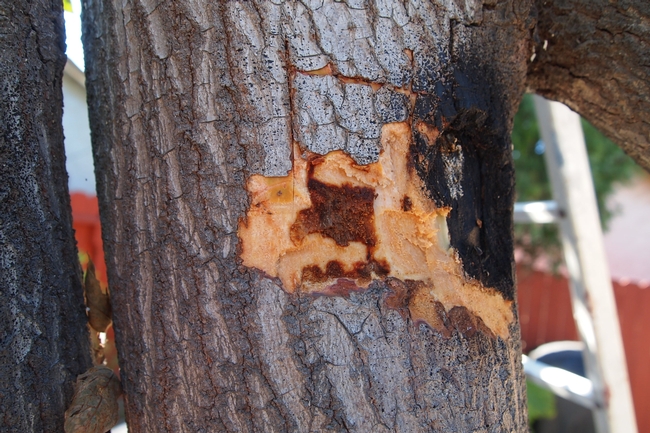
An example of wood discoloration due to Fusarium dieback. Photo credit: Eskalen Lab, UC Riverside
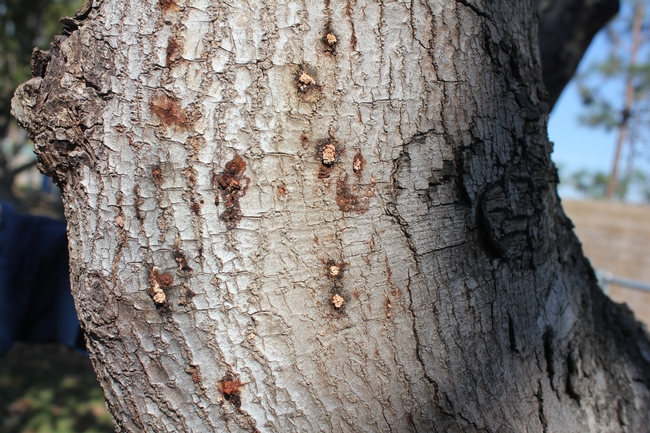
Multiple entry holes on avocado trunk. Photo credit: Eskalen Lab, UC Riverside.


